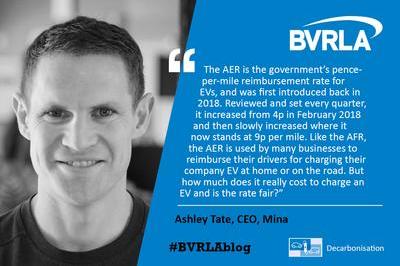Ashley Tate, CEO at BVRLA’s associate member and Fleets in Charge partner Mina looks at reimbursing EV drivers using the AER. Here, Ashley asks how much does it really cost to charge an EV and is the rate fair?

At Mina, we know that electric vehicles (EVs) are the future for fleets. This is especially important for any business who is looking to dramatically reduce their carbon footprint, reach net zero, achieve B Corp Certification (or all three!).
But what happens once you’ve made the switch to electric for your fleet - you’ll need a fair way to pay for their EV charging costs, and perhaps the most obvious thing is for you to turn to the Advisory Electricity Rate (AER).
The AER is the government’s pence-per-mile reimbursement rate for EVs and was first introduced back in 2018. Reviewed and set every quarter, it increased from 4p in February 2018 and then slowly increased where it now stands at 9p per mile. Like the AFR (advisory fuel rate), the AER is used by many businesses to reimburse their drivers, in this instance for charging their company EV at home or on the road.
But how much does it really cost to charge an EV and is the rate fair?
Charging business EVs - the real cost
Variable energy costs can mean that your drivers are reluctant to charge their EVs at home if their charging sessions aren’t being paid for accurately. This could lead them to using the more expensive public charging network as it’s comparably easier to expense charging costs back.
Our latest report shows that the cost of charging an EV on the road rose to an average of 74p per kWh between December 2022-February 2023. Broken down by vehicle type, this gave an average ppm cost of 29p for vans and 20p for cars.
But what if you encourage your drivers to charge their vehicles at home - where electricity rates are much cheaper - to reduce costs and attempt to pay them more fairly?
Using exclusive data from over 125,000 driver charge sessions, our EV report shows that home charging costs are much cheaper than their public equivalent.
This means that if your EV fleet is charging at home, the average cost for driving an electric vehicle is 11p per mile. This leaves 85% of business EV drivers out of pocket if they’re being reimbursed using the AER.
The AER isn’t fit for purpose
Despite the Government’s best efforts to keep up with rising energy costs, our data shows the increased AER always lags behind the actual cost of EV charging.
Take March for example, we found that 4 out of 5 of home charges would leave drivers out of pocket if they were being reimbursed using the AER. On the other hand, 1 out of 5 of those charges meant the business would overpay for their drivers' electric costs.
It was only fair for 0.001% of drivers. So even with the newly increased rate of 9ppm, the AER only benefits an incredibly small percentage if a business is using it to reimburse their drivers for EV charging.
At Mina we’re able to solve the complexity of paying for EV charging costs by eliminating the need to reimburse drivers. Instead, our software accurately pays for EV charging costs at home and in public directly to suppliers. This means drivers are never out of pocket, and both the business and driver can dramatically reduce administrative costs.
Read more about the real cost of EV charging in our report - which also includes analysis of how the winter months affected the range and cost of electric cars and vans.





